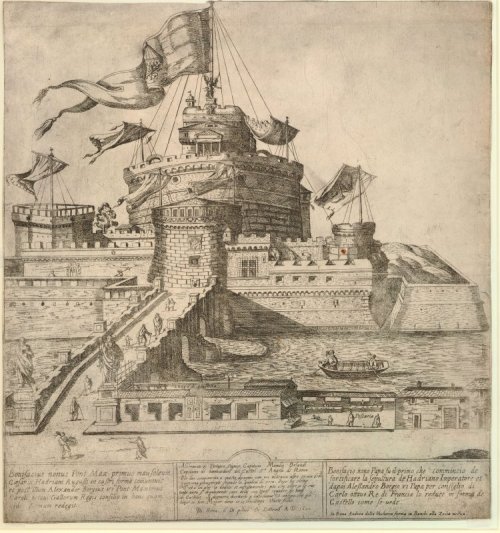Above: The Castel and Ponte Sant’Angelo from the Renaissance to the present.The Ponte Sant’Angelo is
Above: The Castel and Ponte Sant’Angelo from the Renaissance to the present.The Ponte Sant’Angelo is not just a bridge, and the Castel Sant’Angelo is not simply a monumental building. It seems that as their functions have changed throughout the centuries, so too has their symbolic meaning. And perhaps that symbolic meaning has been slowly forgotten, no longer relevant to the modern person. But the uses of the Castel and Ponte Sant’Angelo in the Renaissance and Baroque periods offer a unique insight into Church patronage and how the Church used the urban fabric as a tool to reinforce its position in the lives of pilgrims, and more importantly, as a tool to remind pilgrims of their salvation through Christ.The Castel Sant’Angelo has been in existence since the second-century A.D. It was Emperor Hadrian’s monumental mausoleum, crowned with a statue bearing his likeness. He built the Pons Aelius, now known as the Ponte Sant’Angelo, to connect his tomb to the rest of the city. In 590, the Archangel Michael appeared to Pope Gregory I atop the Castel’Sant’Angelo. Rome was devastated by a plague epidemic, and Michael, wiping his bloody sword, signaled the healing of Rome. In the thirteenth-century, Pope Nicolas III erected a marble statue of the Archangel Michael on top of the Castel Sant’Angelo to commemorate the divine appearance. The statue has been replaced many times since. In the Jubilee Year of 1450, disaster occurred on the Ponte. Approximately 128 pilgrims were trampled to death or crushed by the collapse of some of the Ponte’s outbuildings. This disaster was the catalyst for the changes which resulted in the Castel and Ponte Sant’Angelo that we know today. Over the next two centuries or so, these ancient structures underwent significant modifications, including the creation of the Piazza di Ponte (now sort of the Piazza di Ponte Sant’Angelo) and the construction of Bernini’s twelve angels. To contemporary passer-bys, walking down the Ponte Sant’Angelo alongside Bernini’s angels would mean re-enacting the events of Christ’s Passion in the order they occurred. The bridge became, as Irving Lavin has argued, a Via Salvationis, meeting the Archangel Michael (the weigher of souls) and culminating in the pilgrims’ arrival to Saint Peter’s Basilica. Through these additions, the Castel and Ponte Sant’Angelo became a reminder of the inevitability of divine judgment and the promise of the protection and salvation offered through Christ. -- source link
Tumblr Blog : caravaggista.tumblr.com
#art history#history#italy#ponte santangelo#castel santangelo#ponte project






